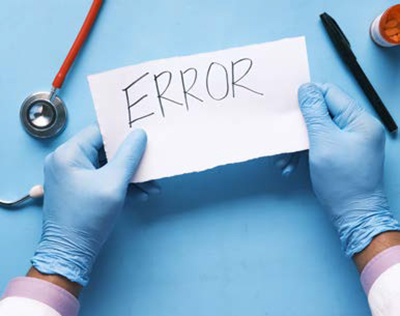Medicolegal issues are more recognized and prevalent in the field of medicine in recent years. They arise from incidents such as wrong-site surgery, limited physician oversight, and medication errors. Medical negligence can potentially risk the longevity of a physician’s career, and strategies to manage risk are key to improving patient outcomes.

The medical profession is widely recognized as one of the most honorable and esteemed occupations across the globe. Its primary purpose is to provide valuable and selfless assistance to humanity. Doctors can alter the course of a patient’s life if they are careful, sincere, efficient, and skilled. However, nowadays, the relationship between providers and patients has become less personal and more formal. Providers are no longer seen as perfect and unquestionable. It is undeniable that humans are prone to making mistakes, and when such errors occur in the medical field, they can have serious and far-reaching consequences. In many instances, these mistakes stem from a combination of minor mishaps and various circumstances that converge – leading to potential catastrophe for the patient. At any point along this chain of events, there is a potential to intervene and prevent a catastrophe. However, if no intervention occurs, the situation may become disastrous. Providers involved in cases of medical negligence can potentially ruin their career and practice potential. The patient-provider relationship, if maintained, builds trust and allows for that trust to decrease the risk of litigation if such errors are maintained. Many patients after medical issues occur who feel connected, heard, and supported by their provider do not choose to consider legal action - given their feeling of good intention overpowering the complications that occurred from lack of oversight.
While most providers aim to establish a positive relationship with patients, it is concerning that nearly two-thirds of physicians aged 55 and older in the United States have faced at least one lawsuit throughout their professional journey. Patients initiate lawsuits because they perceive that their concerns are ignored, their needs were neglected, and a lack of care was demonstrated, leading to unfavorable outcomes. When providers and patients have a solid relationship built on open communication, collaborative decision-making, and realistic expectations, both parties can have a positive healthcare experience.
Clinical negligence is a legal concept used to describe a situation in which a patient has experienced a medical mishap due to receiving inadequate care that falls below acceptable standards. In order to establish a case of clinical negligence, it is not sufficient to merely prove that a breach of duty occurred. It is also necessary to demonstrate causation, meaning that the harm suffered by the patient must directly result from that breach. Even if the quality of medical care provided was exceptionally low, if it did not lead to a substantial outcome or consequence, there is unlikely to be a viable legal case. Medicolegal issues that have gained significant attention involve incidents like performing surgery on the wrong body part, assigning procedures to non-physician operators (e.g. physician assistant, nurse practitioner, or medical trainee), and errors in the preparation of compounded medications.

Clinical errors and malpractice claims are becoming increasingly significant in the field of medicine. One major concern is the potential risk of patients developing debilitating illnesses as a result of medical interventions while hospitalized. This risk not only contributes to the overall cost of healthcare but also adds to the burdens faced by patients. Some common errors are:
1. Avoidance: Physicians should not avoid interacting with patients and their relatives after a bad outcome. Comforting gestures and maintaining eye contact are important.
2. Defensive medicine: Unnecessary medical tests and procedures should be avoided to prevent complaints and potential malpractice.
3. Failure to communicate: Effective communication is crucial. Physicians should ensure that patients understand their diagnosis, treatment, and medications.
4. Failure to diagnose: Not diagnosing correctly is a leading cause of malpractice lawsuits. Patient information and communication play key roles in accurate diagnosis.
5. Failure to identify complications: Consent forms should accurately reflect known risks, and proper communication of complications is essential.
6. Inadequate follow-up: Physicians should ensure test results are received and reviewed and proper follow-up is conducted. Documentation is crucial.
7. Patient time: Allowing patients sufficient time to express concerns and show empathy can reduce the likelihood of a lawsuit.
8. Prescribing errors: Physicians should be aware of patients’ medications, reinforce proper usage, and encourage prompt reporting of any issues. Electronic prescribing and collaboration with pharmacists can help prevent errors.

Medical law is currently experiencing a significant transformation, but there is still much room for improvement in the legal framework regarding professional misconduct and negligence. There are measures that can be taken to reduce or prevent lawsuits related to medical negligence. To minimize legal disputes and create a safer healthcare environment, healthcare providers can implement the following strategies:
1. Prioritize patient satisfaction: Focus on meeting patient needs and ensuring their satisfaction with the care they receive.
2. Adhere to established policies and procedures: Strictly follow the prescribed protocols and guidelines to ensure consistent, standardized care delivery.
3. Foster a patient-centered approach: Place the patient at the center of care by actively involving them in decision-making and considering their preferences and values.
4. Familiarize oneself with effective strategies for defending against malpractice claims: Stay informed about legal practices and strategies to effectively handle and defend against potential malpractice claims.
5. Utilize informed consent: Use informed consent as a tool for effective communication and decision-making, ensuring patients understand medical procedures' potential risks and outcomes.
6. Maintain thorough documentation: Record detailed information about clinical events, decision-making processes, and informed consent to promote transparency and provide a reliable reference for future assessments.
7. Be vigilant in recognizing and managing complications: Stay alert for potential complications and take prompt action to manage them, ensuring patient safety and well-being.
8. Communicate openly and with empathy: Engage in open and compassionate communication with patients and their families, particularly in the event of complications. This fosters trust and reassurance.
9. Maintain regular contact during the post-complication period: Continuously engage with patients and their families, providing support and updates throughout the recovery process to enhance their trust and confidence.
By implementing these techniques, healthcare professionals can deliver optimal care, minimize legal disputes, and create a positive experience for patients.
References:
https://www.ncbi.nlm.nih.gov/pmc/articles/PMC5109754/
https://karger.com/mpp/article/22/4/323/203154/Clinical-Errors-and-Medical-Negligence
https://www.sciencedirect.com/science/article/abs/pii/S152605421730091X?via%3Dihub
https://www.sciencedirect.com/topics/medicine-and-dentistry/medicolegal-issues
https://blog.thesullivangroup.com/10-medical-legal-basics-every-provider-must-know
https://www.sciencedirect.com/science/article/abs/pii/S0738081X15001340?via%3Dihub